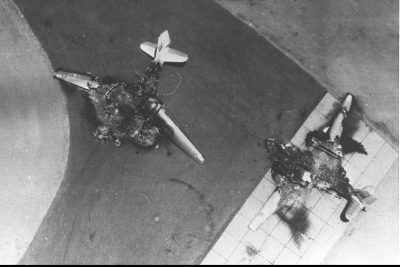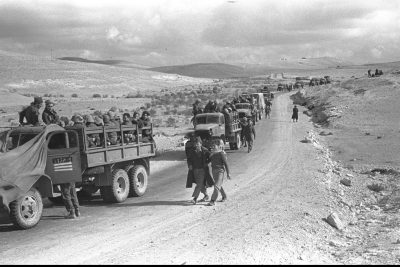
by: Kate Norman, BFP Staff Writer
Israel is a tiny country in a tough neighborhood, surrounded by Muslim-majority states, several of whom would love to wipe the Jewish state off the map. But the tiny Jewish nation in its short 75 years has developed a defense strategy that is defined by the saying: “The best defense is offense.”

On May 9, 2023, the Israel Defense Forces (IDF) launched the surprise Operation Shield and Arrow, eliminating in surgical strikes three top commanders of the Palestinian Islamic Jihad (PIJ) in the Gaza Strip.
But it wasn’t aggression that fueled the operation, which sparked five days of back-and-forth fighting between the IDF and the PIJ. In less than a week, the terror group launched nearly 1,500 rockets toward Israel, prompting retaliatory strikes against more than 700 terror targets. The IDF announced that the PIJ commanders it targeted were behind recent rocket and terror attacks against Israel and that more attacks were imminent.
In the book “Striking First: Preemptive and Preventative Attack in US National Security Policy,” California-based think tank the RAND Corporation noted that Israel opts for anticipatory attacks against impending threats, which allows it to “control the location, speed and duration of operations. It also enables Israel to fight on enemy territory rather than in its own backyard and allows the IDF to mobilize reserve units in advance and achieve its objectives before outside parties interfere, according to the think tank.
Taking the fight to enemy territory before the fight comes to Israel implies that the Jewish state needs to go on the offense to defend itself.
Take Syria, for example. In sporadic (alleged) Israeli air strikes in the war-torn country, the Israeli military targets advanced weapons shipments from Iran bound for its terror puppets perched on Israel’s doorstep—particularly Lebanon-based Hezbollah—as well as weapons manufacturing sites and other terror targets. Israel will not allow Iran to entrench itself on the Jewish state’s doorstep or to arm its terror proxies.
This policy is not new. It has served the Jewish state well throughout its history.
Just a day after the modern state of Israel was reborn on May 14, 1948, five Arab armies invaded, intending to wipe it off the map.
The Arab coalition had been threatening war since November 1947, when the United Nations announced its plan to partition the land and establish side-by-side Jewish and Arab states in the Land of Israel. Almost immediately, Arabs living in Israel and volunteers from neighboring states launched attacks against Jews in the land.
The Haganah, the underground Jewish defense force that preceded the IDF, was comprised of just 60,000 trained fighters sparsely armed with one gun for every three troops. But once the British blockade was lifted, the Haganah quickly armed itself by smuggling, buying and producing heavy weaponry.
After less than a year of fighting, the Israeli military miraculously fought off the invading Arab coalition—thanks largely to switching its fighting tactics from defense to offense. By so doing, the newly formed IDF succeeded in preserving itself and captured additional land.


 The Six Day War
The Six Day WarIn the weeks preceding the Six Day War, Israel knew that a threat was building on the border with Egypt. Cairo had been spewing threats and followed through by amassing 465,000 troops, 800 aircraft and 2,800 tanks along the Jewish state’s border.
Jordanian King Hassan II had attended a meeting of Arab leaders in Morocco in 1965 to decide whether to attack Israel, and the king had secretly recorded the meeting for the Israelis. The recordings instilled confidence in the Israeli military leaders that the Arabs were planning war, but were unprepared, disorganized and divided.
Thus, the Israelis decided to launch a preemptive strike. On June 5, 1967, the Israeli Air Force deployed nearly its entire fleet of planes to strike Egyptian airfields as the Egyptians were enjoying breakfast.
The initial strike decimated most of the Egyptian fleet and half the Syrian air force, surprising the Arabs and crippling their fighting force before they knew what hit them.
Within six days of fighting on three fronts—Egypt in the south, Syria in the east and Lebanon in the north—the Israelis won a stunning defeat. The IDF recaptured eastern Jerusalem and gained control over the Golan Heights, Gaza Strip, Judea and Samaria and the Sinai Peninsula.
In 1973, Israel missed an opportunity to preempt an imminent Arab attack, RAND noted, because the state leaders feared the international response to a preemptive strike.
Egyptian President Anwar Sadat had been threatening to attack Israel for over a year, and multiple IDF chiefs called to mobilize and prepare for war. But Israeli officials did not take the threats seriously.
The Jewish state was taken aback when Egypt invaded from the south and Syria from the Golan Heights on October 6, 1973—on Yom Kippur, the holiest day on the Hebrew calendar.
The Israeli military was woefully outnumbered and out-armed. But after taking a beating during the first two days, the Israeli forces turned the tide and went on the offensive.
Replenished by some 200,000 tons of weapons, tanks and aircraft from the US, the Israelis soon enough drove the invading Arabs out of Israel and even marched toward Cairo in the south and Damascus in the north. But Israel was not interested in invading or capturing foreign territory, and only retained the Golan Heights from Syria.
Though Israel was able to regroup and bounce back from the surprise attack, the Israeli military suffered nearly 2,800 casualties—a heavy price to pay for failure to go on the initial offensive.
The IDF no longer passively waits for its enemies to bring the battle to the Jewish state. The Israeli military keeps constant eyes on enemy powers and often acts preemptively to keep them at bay. The Jewish state maintains the strike first strategy to this day, whether it is fighter jets striking Iranian weapons shipments in Syria or striking terror targets in Gaza to thwart imminent attacks. There are two ways to fight a war: wait for the fight to come to you, or take the fight to the enemy first.
Photo Credit: Click on photo for photo credit
Photo License: Six Day War- Egyptian planes destroyed on the ground
Photo License: Israeli tanks advancing on the Golan Heights
Photo License: Operation Horev - IDF convoy in Negev 1948
All logos and trademarks in this site are property of their respective owner. All other materials are property of Bridges for Peace. Copyright © 2025.
Website Site Design by J-Town Internet Services Ltd. - Based in Jerusalem and Serving the World.